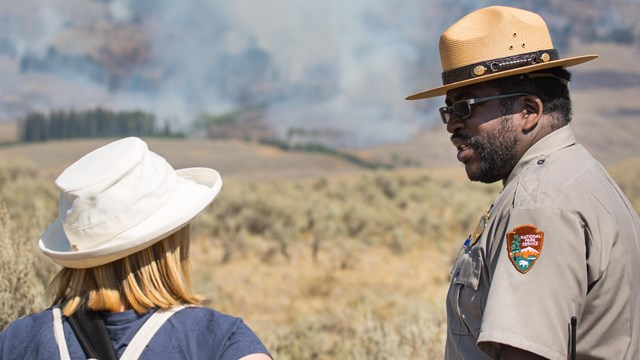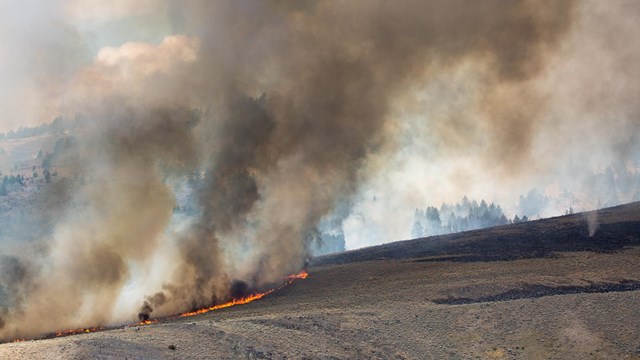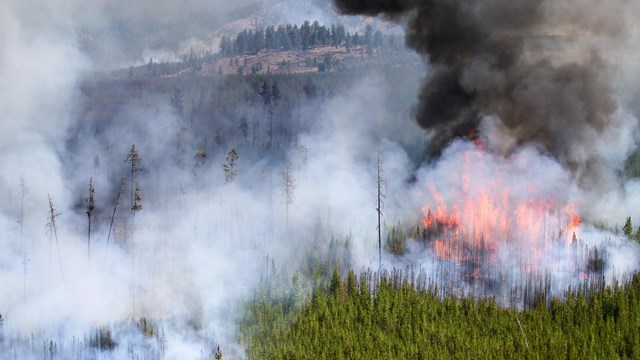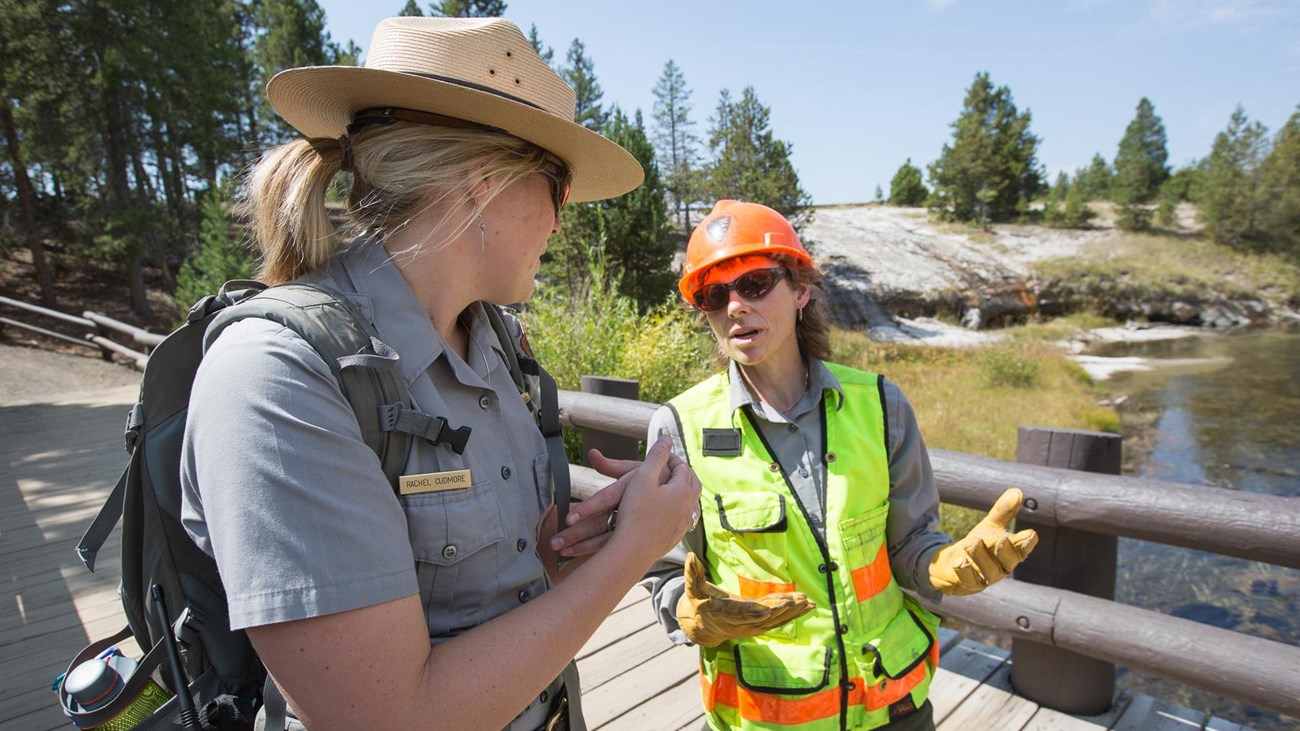|
Visit our keyboard shortcuts docs for details
To celebrate Yellowstone's 150th anniversary, Fire Management Officer John Cataldo talks about the past, present, and future of wildland fire management in Yellowstone National Park. Our GoalsWe let wildfire carry out its ecological role while protecting people and structures.Yellowstone National Park operates under the 2009 Federal Wildland Fire Policy. These guidelines allow fire personnel to manage a lightning-caused fire for multiple objectives. For example, fire personnel can suppress one side of a fire to protect structures and people, while allowing another side to burn to achieve natural fire benefits. We work across boundaries to manage fires.Wildfire is a great example of interagency cooperation and coordination. Federal agencies, state and local governments, and private contractors all play a role in managing fire in the park. We work to reduce hazardous fuels near developed areas.Fuels management includes both planned prescribed burns and other mechanical treatments to change and/or reduce wildland fuels. The goal of Yellowstone National Park's fuels management program is to reduce hazardous fuel loads near developed areas. We monitor the effects of planned fire management actions.The Yellowstone fire effects monitoring crew collects information on the long-term effects of fire and fire management activities. The crew collects data on fuel loads, plant populations, tree regeneration, non-native species and other aspects of the park's ecosystems. Monitoring is a major component of the adaptive management process. 
Managing a Natural ProcessThe National Park Service may allow lightning-ignited fires to burn in Yellowstone provided they are not a threat to human life and property. In an average year, Yellowstone has approximately 24 fires, 80% of which are caused by lightning. The park protects human life as well as the approximately 2% of Yellowstone’s 2.2 million acres that are considered developed (e.g., roads, buildings, and other infrastructure), which includes almost 2,000 buildings, from the threat of fire while at the same time letting wildfire carry out its ecological role in the landscape as much as possible. The Antelope Fire of 2010 was an example of managing a fire for multiple objectives. It was suppressed on its west flank to protect people using the roads and other values at risk. It was monitored, but not suppressed, as it moved south and east away from developed areas. Working Across BoundariesFire management requires interagency cooperation and coordination. For example, the NPS sometimes relies on Forest Service smokejumpers to assist with the park’s remote fires. In return, the National Park Service sends its helicopter or engine to the Silver Gate or Cooke City areas, which are located on or adjacent to the Custer Gallatin and Shoshone national forests. Programmable radios ensure communication between NPS and Forest Service dispatch, which improves firefighter safety. The NPS also works with its partners to develop community wildfire protection plans to help plan and prepare for a wildfire that may threaten homes. 
Wildland Fire ProgramDispatchYellowstone’s Wildland Fire and Aviation Dispatch Center handles fire reports from lookouts, visitors, and park employees, and dispatches appropriate resources to the scene. If additional resources are needed, the dispatch office fills requests with park resources or forwards them to the Billings Interagency Dispatch. The office also manages requests for Yellowstone resources to be dispatched outside the park. Besides tracking all resources for park incidents and areas just outside its boundaries, the dispatch office oversees search and rescue operations, special incidents, flight-following for various aircraft, and ordering and tracking medevac flights for medical emergencies. EnginesYellowstone has one wildland fire engine staffed from May through October. The engine supports local fire management and large firefighting efforts nationwide. Engine crews handle initial attacks near roads but can also reach remote fires by hiking or flying in. They assist with fireline production, structure protection, and helicopter operations, using water to create wetlines that minimize vegetation impact and erosion. For structure protection, the crew conducts structure triage, uses sprinklers, foil wrap, and fuel reduction techniques. Yellowstone also maintains a variety of pumps and water handling equipment for different firefighting needs. HelitackThe Yellowstone Helitack Crew is a ten-person crew that responds to wildfires as well as search and rescue operations (SAR). They manage and staff a Type 3 Helicopter based at Mammoth Hot Springs, seven days a week from mid-June until October. Our helitack crew is trained in all aspects of safe helicopter operations, including size-up and initial attack of wildfires as well as passenger and cargo transport by short haul and longline. When fire activity in Yellowstone is low, the helicopter and crew assist other forests and parks all over the United States with wildfire and SAR operations. When not working on wildfires or assisting with search and rescue operations, crew members assist with fuels projects, hazard tree removal, and assisting the many other park operations where their skills and unique talents are needed. LookoutsThe Yellowstone Fire Management Office maintains two fire lookout stations located on Mt. Washburn (10,219 feet) and Mt. Sheridan (10,308 feet). Only Mt. Washburn is continuously staffed from mid-June until the end of the fire season in the fall. The lookouts serve two primary functions: fire detection and fire monitoring. Each lookout tower is staffed with a trained fire lookout who is provided with cell phones, radios, and high-quality optical equipment. Additionally, each station has a conventional Osborne fire finder—a sighting device used to calculate azimuth and range. Fuels ManagementYellowstone National Park's fuels management program aims to reduce hazardous fuel loads near developed areas through planned prescribed burns and mechanical treatments. Fuels include all plant material that can ignite, influencing fire behavior and its effects on ecosystems. By reducing hazardous fuels, the program enhances firefighter safety, protects structures during wildfires, and mitigates the risk of severe fire to human communities while preserving the health of the Yellowstone ecosystem. Effects MonitoringThe National Park Service's Fire Effects Monitoring Program in Yellowstone focuses on assessing the impacts of planned fire management activities. The dedicated crew collects data on fuel loads, plant populations, tree regeneration, and non-native species to understand the long-term effects of fire. This monitoring aids in adaptive management. Additionally, the crew provides crucial information on weather and fuel conditions through a network of weather stations and monitors precipitation, drought indices, and lightning occurrences to gauge fire danger. During wildfires, they gather data on fire behavior, fuels, vegetation, and weather to assist fire managers in predicting fire dynamics. Questions & Answers Burned trees and those that have died for other reasons still contribute to the ecosystem. For example, dead standing trees provide nesting cavities for many types of animals; fallen trees provide food and shelter for animals and nutrients for the soil. However, park managers will remove dead or burned trees that pose safety hazards along roads or in developed areas.
Fire Season SummarySee current fire activity for information about current fire danger. 2024 FiresThere were nine fires in Yellowstone in 2024. All but one were lightning caused, and the largest fire in the park during 2024 was the Riverside Fire at 4 acres.
2023 FiresThere were five fires in Yellowstone in 2023. All were lightning caused, and the largest fire in the park during 2023 was the Hitching Post Fire at 0.5 acres.
2022 FiresThere were seven fires in Yellowstone in 2022. Six were lightning caused, while one was human caused. The largest fire in the park during 2022 was the Big Horn Fire at 5.8 acres.
2021 FiresThere were 13 fires in Yellowstone in 2021. Eleven were lightning caused, while two were human caused. The largest fire in the park during 2021 was the Corral Fire at 0.7 acres.
2020 FiresThere were nine fires in Yellowstone in 2020. Six were lightning caused, while three were human caused. The largest fire in the park during 2020 was the Lone Star Fire at 4,118 acres.
2019 FiresThere were nine fires in Yellowstone in 2019. Seven were lightning caused, while one was human caused. The largest fire in the park during 2019 was the Brimstone Fire at 217 acres.
2018 FiresThere were eight fires in Yellowstone in 2018. Seven were lightning caused, while one was the result of an escaped campfire. The Bacon Rind Fire, which started in the Custer Gallatin National Forest and burned into Yellowstone, was the largest fire in the park at 5,200 acres.
2017 FiresThere were eight fires in Yellowstone during the 2017 season. Six fires were the result of human activity, while two fires were lightning caused.
2016 FiresThere were 22 fires in Yellowstone during the 2016 season,which burned more than 70,284 acres (28,442 hectares) in the park. Seven fires were the result of human activity, while 15 fires were lightning caused. Eleven fires were suppressed because values were threatened. Many fires were managed to allow them to perform their natural role in the ecosystem. The largest of these fires, the Maple Fire, burned over 51,555 acres in Yellowstone.
More Information
Current Fire Activity
A list of active fires in the park. 
InciWeb
Maps and status of fires across the country. 
Fire Ecology
Learn about fire's role in Yellowstone. 
History of Fire Management
Learn about the history of fire fighting and fire management in Yellowstone. 
Management
Review laws and policies, meet park managers, and examine projects and budgets. Fire Management News |
Last updated: January 7, 2025
